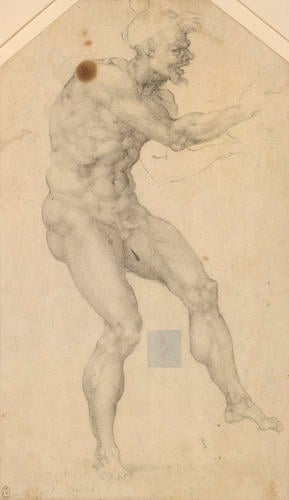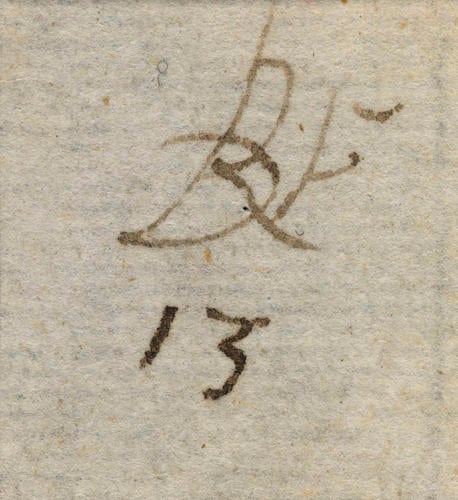-
1 of 253523 objects
A dancing faun 1575 - 1600
Black chalk over stylus | 30.8 x 17.6 cm (sheet of paper) | RCIN 990425

Copy after Michelangelo Buonarroti (Caprese 1475-Rome 1564)
A dancing faun 1575 - 1600

Copy after Michelangelo Buonarroti (Caprese 1475-Rome 1564)
A dancing faun 1575 - 1600


-
A copy in black chalk of a drawing by Michelangelo in red chalk (Louvre), showing a dancing faun.
The drawing reproduces the principal figure of Michelangelo’s drawing of a dancing faun with a tambourine and three putti, of about 1520, in the Louvre, Paris (inv. 697). The outlines appear to have been traced from the original, by going around the outlines with a stylus; there is more stylus work in the modelling of the figure. Johannes Wilde (in P&W) thought the copyist ‘very probably a Netherlander’.
On the verso is a monogram of the letters DRF (and the number 13), which is also found on a drawing of an imaginary city in the Royal Collection (RCIN 906132)L. van Puyvelde thought the monogram might be that of the Antwerp painter David Ryckaert I (1560-1607; the ‘F’ would stand for ‘fecit’, ‘made this’), but this was dismissed by C. White, Dutch and Flemish Drawings ... at Windsor Castle, 1994, pp. 132-3, who noted that there was little to connect these two sheets, and that the monogram might be a mark of ownership rather than an artist's signature. The same monogram occurs on a drawing of Narcissus in a private collection in Rome (Burlington Magazine 1985, p. 758, attributed to Toussaint Dubreuil, c.1561-1602).
The figure was used by Pellegrino Tibaldi for one of the figures in his fresco of Christ before the Pharisees (1553), formerly in the refectory of San Michele in Bosco and now in the Pinacoteca Nazionale, Bologna (inv. 1352).
The top corners of the sheet have been cut, perhaps to shape the drawing for a decorative mount. This cutting of the top corners is found in many drawings with an English seventeenth-century provenance; it could be indicative of a particular collector or could represent a more general fashion adopted by English collectors at that time. Forty-three drawings in the Royal Collection have been shaped in this way (14 of which also bear inscriptions associated with the dealer William Gibson, 1644-1703). It is likely that all these drawings were acquired for the Royal Collection in the seventeenth century, most probably during the reign of Charles II.Provenance
Probably acquired by Charles II. Listed in George III's Inventory A, c.1800, p. 43, 'Mich: Angelo Buonarroti. / Tom. I.': '12. Sketch of an Attitude.'
-
Creator(s)
Acquirer(s)
-
Medium and techniques
Black chalk over stylus
Measurements
30.8 x 17.6 cm (sheet of paper)